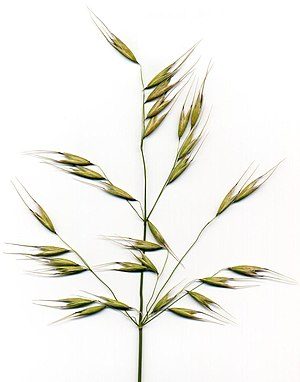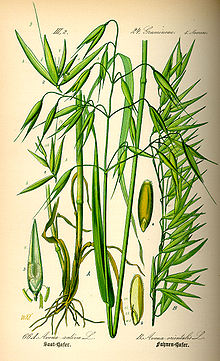oats
| oats | ||||||||||||
|---|---|---|---|---|---|---|---|---|---|---|---|---|

Flight oats ( Avena fatua ), inflorescence |
||||||||||||
| Systematics | ||||||||||||
|
||||||||||||
| Scientific name | ||||||||||||
| Avena | ||||||||||||
| L. |
Oats ( Avena ) is a genus of plants in the sweet grass family (Poaceae). One type , the seed oat , is grown as a grain and, like its seeds, is colloquially called "oats" (Middle High German and regionally also Haber ). The 25 or so species are distributed from Macaronesia through northwest Africa and Spain through the Mediterranean to Western Asia and northeast Africa.
description


Vegetative characteristics
The oat species are annual herbaceous plants . The stalk is hollow and rounded. In contrast to other types of grain, oats lack the auricles. The ligule are narrow to medium-sized, fringed and toothed.
Generative characteristics
The oat species are bluegrass . Oats differ from other types of grain in the shape of the fruit cluster, which is designed as a panicle and not as an ear , which shows that it is far removed from other types of grain in the system. The thousand grain weight is 27-48 grams.
Systematics and distribution
The genus Avena was established in 1753 by Carl von Linné . Synonyms for Avena L. are Preissia Corda , Anelytrum Hack.
The original distribution area of the genus Avena extends from Macaronesia through northwest Africa and Spain through the Mediterranean to the Middle East and northeast Africa. Most of the biological species are found in southern Spain and northwestern Africa.
There are about 25 species in the genus Avena :
- Avena abyssinica Hochst. : It occurs in Ethiopia , Eritrea and Djibouti .
- Avena aemulans Nevski : It occurs in European Russia .
- Avena agadiriana B.R.Baum & G.Fedak : It occurs only in western Morocco .
- Avena atlantica B.R.Baum & G.Fedak : It occurs only in western Morocco.
- Bearded oats ( Avena barbata Pott ex Link ): It is widespread from North Africa and the Mediterranean to Central Asia and the western Himalayas and is a neophyte in the New World, South Africa and Australia .
- Short oats ( Avena brevis Roth ): It occurs in the Canary Islands , Azores and Madeira and was cultivated in Spain, Portugal, France and Great Britain, less often in Central Europe.
- Mediterranean oats ( Avena byzantina K.Koch ): It is widespread in northwest Africa, in the Mediterranean region and in Western Asia as far as Iran.
- Avena canariensis B.R.Baum, Rajhathy & DRSampson : It occurs in Lanzarote and Fuerteventura .
- Avena chinensis (Fisch. Ex Roem. & Schult.) Metzg. : It occurs in culture in Central Europe.
- Avena clauda Durieu : It occurs from the eastern Balkan Peninsula to West and Central Asia and in northwest Africa.
- Avena eriantha Durieu : It occurs from North Africa to Central Asia and Afghanistan and in Greece .
- Flight oats ( Avena fatua L. ): It occurs in the temperate areas of Eurasia , in North Africa and Macaronesia. It is a neophyte in South Africa, North America, Mexico, South America, Australia and New Zealand.
- Avena longiglumis Durieu : It occurs in the Mediterranean area.
- Avena maroccana Gand. : It occurs in Morocco.
- Avena murphyi Ladiz. : It occurs in southwestern Spain and Morocco.
- Naked oats ( Avena nuda L. ): It is cultivated from Portugal to Great Britain and Germany and is a weed in cereals in Northern, Central and Eastern Europe.
- Avena prostrata Ladiz. : It occurs in the Murcia region in southeastern Spain and in Morocco.
- Seed oats ( Avena sativa L. ), also known as “real oats”, only known in culture. Probably comes from West Asia .
- Avena saxatilis (Lojac.) Rocha Afonso : It occurs only on the islands of Lipari , Marettimo and Linosa .
- Deaf oats ( Avena sterilis L. ): The two subspecies occur from the Mediterranean to Kenya and the western Himalayas and the Canary Islands:
- Sand oats ( Avena strigosa Schreb. ): It occurs in southwestern Europe and is otherwise cultivated in Europe, less often in northern, central and eastern Europe.
- Avena vaviloviana (Malzev) Mordv. : It occurs in Eritrea and Ethiopia .
- Avena ventricosa Balansa : It occurs from North Africa to Iran and Saudi Arabia .
- Avena volgensis (Vavilov) Nevski : It occurs in European Russia.
use
Seed oats are mainly used as animal feed and as food in the form of oat flakes . Various extracts are obtained from oats for use in medicine. A drink made from oats (" oat milk ") is used as a substitute for cow's milk .
Wild oat varieties were processed into flour ( oat flour , from Middle High German habermël , flour from Avena sativa) 32,000 years ago . The closest related variety to the modern seed oat is Avena sterilis , which comes from the Fertile Crescent . Since around 1000 BC Oats were grown in Europe, but mainly used as animal feed. Oats later became a staple food for people in colder climates such as Germany, Scandinavia, Ireland and Scotland.
literature
- information.medien.agrar eV (Ed.): Plants in agriculture. 2004, PDF file .
- Wilfried Seibel (Hrsg.): Commodity knowledge of cereals - ingredients, analysis, cleaning, drying, storage, marketing, processing . Agrimedia, Bergen / Dumme 2005, ISBN 3-86037-257-2 .
- Walter Erhardt, Erich Götz, Nils Bödeker, Siegmund Seybold: The great pikeperch. Encyclopedia of Plant Names. Volume 2. Types and varieties. Eugen Ulmer, Stuttgart 2008, ISBN 978-3-8001-5406-7 .
- Maria da Luz de Oliveira Tavares Monteiro da Rocha Afonso: Avena L. In: TG Tutin, VH Heywood, NA Burges, DM Moore, DH Valentine, SM Walters, DA Webb (eds.): Flora Europaea . Volume 5: Alismataceae to Orchidaceae (Monocotyledones) . Cambridge University Press, Cambridge 1980, ISBN 0-521-20108-X , pp. 206–208 (English, limited preview in Google Book Search).
- Hans Joachim Conert: Avena. In: Hans Joachim Conert (ed.): Illustrated flora of Central Europe . Founded by Gustav Hegi. 3rd, completely revised edition. Volume I. Part 3: Spermatophyta: Angiospermae: Monocotyledones 1 (2). Poaceae (real grasses or sweet grasses) . Parey Buchverlag, Berlin 1998, ISBN 3-8263-2868-X , p. 212–227 (published in deliveries 1979–1998, 3rd delivery, 1985).
Web links
- Oats (Avena sativa L.) . In: University of Hamburg
- Oats . In: Loki-Schmidt-Haus useful plant museum
- Stefanie Jacomet: Oats. In: Historical Lexicon of Switzerland .
Individual evidence
- ↑ Duden: Haber .
- ↑ a b c d e f g h i j k l m n o p q r s t u v w x y z Rafaël Govaerts (Ed.): Avena. In: World Checklist of Selected Plant Families (WCSP) - The Board of Trustees of the Royal Botanic Gardens, Kew . Retrieved November 2, 2016.
- ↑ Jürgen Martin: The 'Ulmer Wundarznei'. Introduction - Text - Glossary on a monument to German specialist prose from the 15th century. Königshausen & Neumann, Würzburg 1991 (= Würzburg medical-historical research. Volume 52), ISBN 3-88479-801-4 (also medical dissertation Würzburg 1990), p. 135 ( Haber , Habermël ).
- ↑ Oldest Flour Ground 32,000 Years Ago on seeker.com, accessed April 6, 2017.
- ↑ Marta Mariotti Lippi et al: Multistep food plant processing at Grotta Paglicci (Southern Italy) around 32,600 cal BP In: PNAS . 112 (39), 2015, pp. 12075-12080, doi: 10.1073 / pnas.1505213112 .